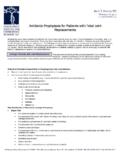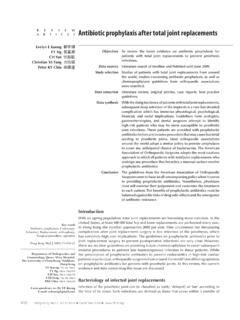Transcription of Delphi consensus on bile duct injuries during …
1 Accepted ArticleThis article has been accepted for publication and undergone full peer review but has not been through the copyediting, typesetting, pagination and proofreading process, which may lead to differences between this version and the Version of Record. Please cite this article as doi: This article is protected by copyright. All rights reserved. Guideline Delphi consensus on bile duct injuries during laparoscopic cholecystectomy: An evolutionary cul-de-sac or the birth pangs of a new technical framework? Yukio Iwashita, Taizo Hibi, Tetsuji Ohyama, Akiko Umezawa, Tadahiro Takada, Steven M. Strasberg, Horacio J. Asbun, Henry A. Pitt, Ho-Seong Han, Tsann-Long Hwang, Kenji Suzuki, Yoo-Seok Yoon, In-Seok Choi, Dong-Sup Yoon, Wayne Shih-Wei Huang, Masahiro Yoshida, Go Wakabayashi, Fumihiko Miura, Kohji Okamoto, Itaru Endo, Eduardo de Santibanes, Mariano Eduardo Gim nez, John A. Windsor, James Garden, Dirk J. Gouma, Daniel Cherqui, Giulio Belli, Christos Dervenis, Daniel J.
2 Deziel, Eduard C. Jonas, Palepu Jagannath, Avinash Nivritti Supe, Harjit Singh, Kui-Hin Liau, Xiao-Ping Chen, Angus Chan, Wan Yee Lau, Sheung Tat Fan, Miin-Fu Chen, Myung-Hwan Kim, Goro Honda, Atsushi Sugioka, Koji Asai, Keita Wada, Yasuhisa Mori, Ryota Higuchi, Takeshi Misawa, Manabu Watanabe, Naoki Matsumura, Toshiki Rikiyama, Naohiro Sata, Nobuyasu Kano, Hiromi Tokumura, Taizo Kimura, Seigo Kitano, Masafumi Inomata, Koichi Hirata, Yoshinobu Sumiyama, Kazuo Inui, Masakazu Yamamoto The author s affiliations are listed in the Appendix. Corresponding author: Tadahiro Takada, , Department of Surgery, Teikyo University School of Medicine 2-11-1, Kaga, Itabashi-ku, Tokyo, Japan 173-8605 Phone: +812 3964 1211 ext. 1424 Fax: +813 3961 6944 Accepted ArticleThis article is protected by copyright. All rights reserved. Keywords: Laparoscopic cholecystectomy, bile duct injury, Delphi consensus , Critical view of safety, surgical difficulty Abstract Background Bile duct injury (BDI) during laparoscopic cholecystectomy remains a serious iatrogenic surgical complication.
3 BDI most often occurs as a result of misidentification of the anatomy; however, clinical evidence on its precise mechanism and surgeons perceptions is scarce. Methods Surgeons from Japan, Korea, Taiwan, and the , etc. (n = 614) participated in a questionnaire regarding their BDI experience and near-misses; and perceptions on landmarks, intraoperative findings, and surgical techniques. Respondents voted for a Delphi process and graded each item on a five-point scale. The consensus was built when 80% of overall responses were 4 or 5. Results Response rates for the first- and the second-round Delphi were and , respectively. Misidentification of local anatomy accounted for of BDI. Final consensus was reached on: 1) Effective retraction of the gallbladder, 2) Always obtaining critical view of safety, and 3) Avoiding excessive use of electrocautery/clipping as vital procedures; and 4) Calot s triangle area and 5) Critical view of safety as important landmarks.
4 For 6) Impacted gallstone and 7) Severe fibrosis/scarring in Calot s triangle, bail-out procedures may be indicated. Conclusions A consensus was reached among expert surgeons on relevant landmarks and intraoperative findings and appropriate surgical techniques to avoid BDI. Accepted ArticleThis article is protected by copyright. All rights reserved. Introduction Laparoscopic cholecystectomy (LC) is a widely accepted standard procedure that is performed across the globe; however, its safety has yet to be established. The incidence of bile duct injury (BDI) during LC ranges between and , is reported to be higher than an open cholecystectomy, and remains an uncommon but one of the most serious iatrogenic surgical complications (1 3). In extreme BDI cases, a liver resection or even liver transplantation is required (4, 5). BDI is not only associated with increased medical costs but also an increased mortality rate, which can be as high as 21% (6, 7).
5 BDI during LC most often occurs as a result of misidentification of the common hepatic/bile duct as the cystic duct (8 10). The technique to establish a critical view of safety (CVS) (11) has been adopted worldwide to prevent misidentification. Disappointingly, the number of BDI cases does not seem to have gone down over the years, despite the introduction of other safety measures such as intraoperative cholangiography (12), use of landmarks other than CVS (13, 14), and efforts to facilitate surgical education (15, 16). BDI may also occur in difficult situations, particularly in acute cholecystitis (AC) (17, 18). A recent study demonstrated an increased risk of BDI according to the severity grade of AC per Tokyo Guidelines 13 (19, 20). In addition, Strasberg and Gouma (21) reviewed eight cases of extreme vasculobiliary injury in details, the most severe type of BDI, and concluded that the fundus-down technique should be strictly avoided for AC cases with severe inflammation.
6 Our group has been vigorously working on the establishment of best practice for cholecystitis and it is our fervent desire to prevent and eradicate BDI (22, 23). Heinrich (24) claimed that for every major injury, there were 29 minor injuries and 300 no-injury accidents or near-misses, this is well known as Heinrich s safety pyramid. Therefore, investigations on near-miss events are of paramount importance to avoid serious complications during an operation and they also provide a rich source of learning (25, 26). In LC, clinical evidence is currently scarce on when, where, and why surgeons experience BDI or a near-miss, how can we avoid or reduce the risk of BDI, and what are the alternative bail-out procedures when BDI is likely to occur. In the present study, we conducted an international survey Accepted ArticleThis article is protected by copyright. All rights reserved. among expert LC surgeons in Japan, Korea, Taiwan, the , and other nations on BDI during LC and aimed to reach a consensus on risk management strategies by using the Delphi method.
7 Methods A total of 614 expert LC surgeons in Japan, Korea, Taiwan, the , and other nations were invited to participate in the first- and second-round Delphi process in a web-based, English questionnaire survey. The questionnaire consisted of eight questions regarding their BDI experience and its risk management strategies and was created by 12 expert LC surgeons in Japan working at tertiary hepatobiliary and pancreatic surgical institutions, using the nominal group technique. The first round was conducted in April 2017. Questions 1 and 2 consisted of workplace (by nation) and lifetime experience in LC and open cholecystectomies (total caseloads were categorized into four different levels: 1 199, 200 499, 500 999, and 1,000). Questions 3 and 4 focused on their personal experience of BDI and near-misses. Questions 5 8 were designed to establish a consensus on the situations and landmarks or intraoperative findings that were likely to be associated with BDI and on the surgical techniques that could be used to avoid, or reduce the risk of, BDI.
8 Respondents were asked to grade each factor according to its importance on a five-point scale (Likert scale) of 1 (not at all important) to 5 (very important). The second round took place in May 2017 and questions 1, 2, and 5 8 were repeated. To build a consensus among expert LC surgeons on perceptions of BDI, an anonymous summary of the first-round Delphi was provided together with the questions. The results from the first round were expressed as percentage of respondents for each answer option (from 1 to 5) and the median (interquartile range) for each factor. Each respondent had the option to either retain or change his/her initial opinion in the first round with reference to the response of the entire group. A complete version of the questionnaire is depicted in supplementary Figure 1. Delphi consensus was reached when at least 80% of respondents ranked an item as 4 or 5 on a Likert scale of 1 to 5, in accordance with the Society of American Gastrointestinal and Endoscopic Surgeons (SAGES) Delphi consensus (27).
9 Data from the second-round Delphi were further stratified by workplace and LC experience level. All data were collected using Microsoft Office Excel 2010. Accepted ArticleThis article is protected by copyright. All rights reserved. Results Respondent characteristics A link to the web-based questionnaire was sent via email to a total of 614 surgeons for the first- and second-round Delphi . The response rates were % (Japan, n = 279; Korea, n = 39, Taiwan, n = 34; the and others, n = 20) and (Japan, n = 287; Korea, n = 60, Taiwan, n = 92; the and others, n = 21) for the first and second rounds, respectively. Table 1 shows the distribution of lifetime cases among nations. In Korea and the and others, >60% of surgeons experienced >1,000 cases and this ratio was higher than that of Japan and Taiwan. Field study Overall, the number of respondents who experienced BDI or near-misses was 267/372 ( ) and the ratio increased as experience accumulated, reaching >80% among surgeons who had performed >1,000 cases during their career (Table 2).
10 Of these, 205 recalled that misidentification of local anatomy was the main reason for BDI and near-misses. One hundred forty surgeons recognized misidentification after BDI, corresponding to of the entire group. BDI and near-misses most often occurred during the dissection of the Calot s triangle area ( ) and around the cystic duct ( ) (Table 3). Misidentification of the common bile/hepatic duct instead of the cystic duct was the most common reason of BDI ( ), followed by the hepatic artery instead of the cystic artery ( ) (Table 4). Misrecognition was revealed by the identification of a landmark ( ), followed by intraoperative cholangiography ( ) and advice from a member of the surgical team other than the operator ( ). Delphi study In the first-round Delphi , the five items for which 80% of the respondents had graded either a 4 or 5 on a five-point scale (1, not at all important; 5, very important) were: A) Impacted gallstone in the confluence of the cystic, common hepatic, and common bile duct and B) Severe fibrosis and scarring in Calot s triangle due to inflammation in the When to stop category (high-risk intraoperative situations that are likely to be associated with BDI); C) Calot s triangle area and D) CVS in the Accepted ArticleThis article is protected by copyright.





